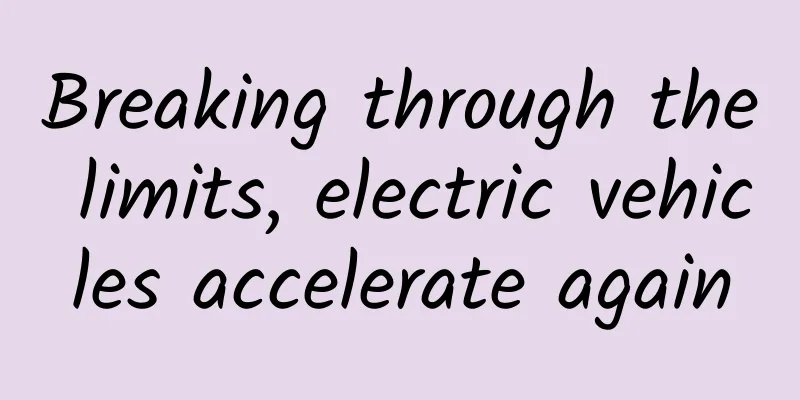Breaking through the limits, electric vehicles accelerate again

|
With the development of the past year, the world has entered a new era of electric mobility. European and American regulators have introduced increasingly aggressive greenhouse gas emission targets for passenger cars and other light vehicles with a sense of urgency. Major automakers have also stepped up their efforts to launch electric vehicle options in their product portfolios. These driving factors have combined to greatly promote the development of the global electric vehicle market. BCG predicts that pure electric vehicles are expected to become the world's best-selling light vehicle power category in 2028 - three years earlier than our 2021 report predicted. In addition, we expect that global pure electric vehicle sales will exceed the sum of all hybrid types of vehicles by 2030 , even leaving fuel vehicles far behind. At the same time, our updated model also has a more optimistic outlook on the future health of the planet. The European Union’s announcement to ban the sale of fuel vehicles from 2035 will undoubtedly completely change the global automotive industry; the EU is also expected to achieve its 2050 greenhouse gas emission reduction targets in the transportation sector. Although the United States still has a long way to go to achieve its climate goals, the situation has improved significantly compared to our assessment of its transportation industry in 2021 . However, behind the bright prospects lies a " thorn " . For the automotive industry, the rising demand for electric vehicles on the consumer side has spawned new challenges or exacerbated old problems. Among them, players in the battery supply chain and charging infrastructure suppliers are struggling to keep up with the explosive growth in demand. To ultimately win the market, automakers must find ways to solve supply chain problems, adopt innovative methods, and work closely with other players to create a practical and effective ecosystem. A fruitful year 2021 was a stellar year for electric vehicles, including hybrids . As vehicle production rebounded from the COVID-19 pandemic, electric vehicles accounted for 20% of all light vehicle production in 2021 , compared with just 12% in 2020. In contrast, the share of gasoline and diesel vehicles fell by 9 percentage points. Sales of pure electric vehicles and plug-in hybrids have been soaring, with sales doubling in the United States (although from a low base relative to other markets) and tripling in China. There are several reasons for this strong performance.
An industry in transition Electrification is the future of the automotive industry. All of these drivers will accelerate the pace at which pure electric vehicles gain market dominance, even faster than we previously thought. According to the latest forecast, pure electric vehicles will account for 20% and 59% of global light vehicle sales in 2025 and 2035 , respectively (see Figure 1 ). In contrast, our forecast in last year’s report predicted that pure electric vehicles would account for 11% and 45% of global light vehicle sales in 2025 and 2035 , respectively . The market share of hybrid and plug-in hybrid vehicles in 2025 and 2035 is almost unchanged between last year and this year’s forecasts. Compared with our forecast last year, the main difference in BCG ’s forecast this time is the updated insight that pure electric vehicle growth is driven by the accelerated transition away from gasoline vehicles and mild hybrid vehicles in major markets around the world. We expect the rate of growth of pure electric vehicle adoption to vary across the world. The European Union, with its stringent stance on environmental regulations, is likely to lead the way, with electric vehicles expected to account for more than 90% of EU light vehicle sales by 2035. Electric vehicle adoption in China and the United States lags behind the EU, but will also grow rapidly. However, adoption will be much slower in the rest of the world: outside the major markets of China, the United States, and the EU, pure electric vehicles are expected to account for only 35% of light vehicle sales in 2035 , while more than 50% of new gasoline and diesel vehicles sold globally by 2027 will be purchased by consumers in these regions. Therefore, global automakers must still maintain a cost-effective fuel vehicle supply chain to meet the strong demand for hybrid and fuel vehicles that will continue to exist in many markets around the world. Amid the surge in electric vehicle consumption, many new models are sold out within minutes of their launch, and many automakers are excited about their electric vehicle production and sales that are far higher than expected. At the same time, the rising enthusiasm for electric vehicle consumption is also constantly attracting emerging electric vehicle players to enter the market, all of whom hope to replicate Tesla's huge success (Tesla's market value is much higher than any other automaker). At the same time, the trend of electric vehicle transformation has also forced traditional automakers to reconsider not only the transition from internal combustion engines to electric powertrains, but also whether to change the entire business model. They actively promote vertical integration to improve the channels for battery supply to ensure the first access to the next generation of battery technology and improve the performance of electric motors. Considering the lower maintenance requirements of electric vehicles and the direct sales model of new car manufacturers, the evolution of the role of dealers has become inevitable. More revolutionary is that automakers are shaping a new model of " car as a service " by packaging electric vehicles as energy storage devices with tires , and are entering the service field traditionally provided by public utilities or fleet management companies. In addition, the recycling requirements for scrapped vehicle parts are becoming more and more stringent, prompting automakers to seriously consider market entry strategies around recycling, such as battery recycling and remanufacturing. At the same time, automakers are also taking simplified electronic architecture and software-driven approaches to cut costs and create new sources of revenue to make up for the low short-term profit margins of electric vehicles. For example, through "OTA remote updates " (i.e. wireless push of software and functions), automakers can remotely increase the mileage of electric vehicle batteries, and can also use vehicle identification technology to allow electric vehicle owners to automatically pay after using charging facilities. In short, traditional automakers and new car-making forces who are good at market insight have realized that the transformation of electric vehicles can expand and deepen the profit pool of the automotive industry. Finally, emerging autonomous fleet operators are also favoring electric vehicles due to factors such as emissions regulations and lower per-mile costs than fuel vehicles. We expect that in the future all autonomous shared vehicles (including fleet vehicles) will be electric, which will further expand the penetration and acceptance of electric vehicles. Climate goals are getting closer The world still has a lot of work to do to catch up on climate goals for transport. But the growing prospects for electric vehicles are good news, although policymakers and automakers must act with urgency to accelerate adoption and address barriers to the electric vehicle revolution. By preparing for a ban on the sale of fuel-powered cars in 2035 (which should become legally binding in 2023 or 2024 ), the EU could reach net zero emissions for all vehicles on the road by 2050 , provided it continues to invest in public transport and green mobility options such as e-bikes. By then, almost all vehicles on the road will be zero-emission, and according to our latest forecasts, the EU still has a chance to meet its informal target of a 45%-50% reduction in vehicle emissions by 2030 (from 2005 levels). Still, stronger action is needed to ensure that the EU's fleet is completely restructured from gasoline to electric , that owners of plug-in hybrids use electricity rather than gasoline, and that the most car-using consumers choose to buy electric vehicles. Earlier this year, electric vehicles accounted for more than 20% of new light vehicle sales in China , so we think it is not difficult for China to achieve its goal of 40% of new vehicles sold by pure electric vehicles by 2030. However, if China wants to achieve its 2060 carbon neutrality goal, it must achieve 100% electric vehicles in new light vehicle sales by 2040 . The United States will also have to catch up to meet its goals. Although we believe the United States still has a window of opportunity to achieve its goal of only selling zero-emission vehicles by 2030, the pace of change in the structure of the U.S. vehicle fleet is not fast enough to easily achieve its goal of reducing emissions in the economy by 50% by 2030 (based on 2005 levels). Just as the European Union has implemented a ban, the United States must ban the sale of non-zero-emission vehicles by 2035 to fulfill its commitment to net zero emissions by 2050 . Looking around the world, Japan is expected to achieve net zero greenhouse gas emissions in the economy by 2050 due to the high proportion of hybrid vehicles in its car ownership , but it still needs to set clear zero-emission vehicle targets to ensure that it stays on track. Meanwhile, the Geneva-based World Business Council for Sustainable Development and 25 leading Indian companies have called for pure electric vehicles to account for 30% of new vehicles sold in India by 2030. However, we predict that the proportion of new electric vehicles sold in India in 2030 will be less than 15% , about half of the target. Unless there is a qualitative change in the Indian automotive market and regulatory environment, it will be difficult for India to achieve the corresponding target (see Figure 2 ). Zero carbon emissions do not stop at electric vehicles themselves. Looking at the automotive value chain, decarbonization is the general trend. For example, charging companies use methods such as installing solar charging piles and obtaining renewable energy to solve the need for electric vehicles to use clean energy. Battery manufacturers are also actively using green energy in the production and manufacturing process. However, past consumption trends combined with specific problems of electric vehicles will still weaken consumers' enthusiasm for purchasing electric vehicles and the positive impact of electric vehicles on the climate. Risks to the spread of electric vehicles Despite the momentum of electric mobility, two major short-term supply chain risks have also emerged, which may hinder the pace of industrial transformation or prompt industry players to achieve breakthrough innovations in the process of overcoming difficulties. The first is the supply chain tension of power battery metal raw materials, including lithium and nickel, which has emerged in the past six months. The second is that the imperfection of charging infrastructure in the next few years will lead to stagnation of electric vehicle penetration in major markets, including the United States. Among them, cities such as Boston are particularly affected. Due to local logistics issues and the limitations of existing distribution facilities, it is very time-consuming to expand their distribution capacity. Based on our market outlook for global pure electric vehicle and plug-in hybrid vehicle sales, supply chain players should accelerate their layout in related fields to keep up with future changes in demand (see Figure 3 ). For example, lithium demand is expected to soar at a compound annual growth rate of more than 25% from this year to 2030. However, supply chain constraints caused by the epidemic, coupled with rising energy costs and accelerated growth in electric vehicle sales, have caused the price of lithium compounds used to produce batteries to soar - the average cost of batteries is rising after years of steady decline. At the same time, wars and economic sanctions have raised nickel prices, which may further exacerbate the shortage of nickel. Filling the gap in the metal material supply side and curbing price increases depends on whether manufacturers can build new factories to meet the rising demand. But building a factory is not an easy task because the production engineering construction cycle is relatively long. As long as the gap in raw material supply persists, the expansion of battery production capacity, battery mileage, and battery life extension technology development will be constrained, ultimately delaying or even reversing the trend of falling electric vehicle ownership costs. In the near future, the situation of inadequate charging stations may worsen in some countries. Recently, the UK Automobile Industry Association stressed that the current growth rate of electric vehicle sales is far outstripping the construction of public charging stations. According to our analysis, the United States will need 1.1 million and 2.3 million public charging stations in 2025 and 2030 respectively , compared with only 100,000 in 2020. The government only plans to build 500,000 public charging stations by 2026 , and the US Infrastructure Investment and Jobs Act may only fund one-tenth of them - leaving the rest to the private sector and state governments. The lack of infrastructure may have a profound negative impact on the popularity of electric vehicles. Now a group of potential car buyers have emerged. They have neither garages nor single-family homes, and cannot charge at home. Therefore, in the future, they will need to rely more on public charging facilities distributed all over the country. However, according to a recent survey by the non-profit consumer organization Consumer Reports, concerns about the lack of public charging piles have become the main factor for American consumers to hesitate to buy electric vehicles. At the same time, Germany is also gradually canceling the purchase incentives for private charging piles, encouraging more and more electric car owners to use public charging stations. New challenges on the track The rapid changes in the automotive industry, especially the time when pure electric vehicles will dominate the market, are likely to come much faster than we previously predicted, which has brought new bottlenecks to industry players. Now, industry players must focus on breaking supply chain constraints and solving the problem of insufficient charging facilities discouraging buyers, rather than simply proving the feasibility and value of electric vehicle technology and application scenarios. At the same time, as the market development accelerates, automakers and suppliers are changing their strategies to seize new opportunities and eliminate potential risks. Innovative achievements are emerging in all areas, covering technology, user experience, revenue models, and vehicle usage models. Innovative progress has not limited the industry to individual solutions, but has broadened the choices of electric vehicle players. Therefore, companies can formulate strategies based on different market scenarios and opportunities. Collaboration is essential to overcoming these challenges. Fortunately, there is reason to be optimistic that players in the automotive ecosystem are ready to collaborate actively to develop viable solutions, rather than viewing it as a zero-sum game. On the charging side, a large number of players are accelerating the layout of public charging piles. The government has liberalized land rights and supported large-scale projects such as wireless charging of electric vehicles. Charging facility manufacturers have built prefabricated charging piles to shorten installation time. Automakers have joined hands with utility companies to implement pilot projects to increase grid capacity and flexibility, ensuring that electric vehicle owners can charge at home or sell excess electricity back to the grid. As special electricity charges for car charging, intelligent vehicle architecture, and universal standards are implemented one by one, the charging cost of electric vehicles is bound to fall. Through innovative breakthroughs, automakers have taken car charging to a whole new level. They have developed " battery swapping " and " battery as a service " models, which have long been common in electric two-wheeled and three-wheeled vehicles. For example, NIO provides consumers with a subscription service where they can exchange old batteries for new ones at battery swap stations. This model solves consumers' concerns about battery life and scrapping, creates a new source of revenue for automakers, and promotes recycling and reuse. To improve the resilience of the supply chain, automakers, battery manufacturers, and cathode material suppliers have joined forces to establish joint ventures and invest in minerals, committed to ensuring stable supply and building competitive advantages. New technologies such as direct lithium extraction are also being closely developed and are expected to open up new sources of key lithium metals. At the same time, in order to hedge risks, electric vehicle players are exploring multiple technical paths. Two years ago, electric vehicle companies began to abandon lithium iron phosphate batteries and embrace lithium batteries with a higher nickel content. However, with the recent changes in market dynamics, the demand for lithium iron phosphate batteries has begun to rebound, especially in entry-level cars, and automakers have therefore reduced their dependence on nickel. All of these initiatives demonstrate that the auto industry is quick to act and innovate when faced with a major challenge. Leading automakers are still creating a satisfying customer experience for consumers and creating significant value for shareholders. Not only that, but automakers are also setting an example for other industries to follow in addressing the challenges of climate change. We believe that as automakers gradually establish electrification as a mainstream travel technology, even bigger and more surprising innovations will emerge. Please fasten your seat belts, the auto industry is moving full speed ahead towards a net zero future. From: BCG |
Recommend
Xiaohongshu platform marketing strategy!
As more and more brands begin to use Xiaohongshu ...
Master 5 key elements to easily capture tens of millions of users
I believe that the three factors that determine t...
The world's first "gar" is in Yunnan? The ancestor of the water's little tyrant has been discovered
The gar, which now lives in the freshwater enviro...
Do dung beetles also "pick up poop"? Why do they roll dung balls?
Expert: Zhang Qikai, Chinese Academy of Agricultu...
Baidu and Volkswagen have reached a strategic cooperation and the research and development project around autonomous parking has been launched
On November 2, the second Baidu Apollo Council wa...
Lithium iron phosphate is recovering, and the dominance of ternary materials may change
Recently, the market situation of the rise of ter...
What should Tik Tok do to become popular? Tips to become popular on TikTok
This article mainly introduces how to become popu...
Want to get the most active and high-quality users? You should know these promotion methods
App stores are the main platform for app promotio...
"I am willing to dedicate my life to the country!" He has been working incognito for 17 years for the nuclear industry of his motherland, and now he is still young after returning from his 70s
May 28 He is an academician of the Chinese Academ...
Three colors in one day! This flower can actually "change its face", don't miss it in autumn~
All the flowers have fallen, but the fragrance re...
Epidemic prevention, weather...Important reminders, regarding the "Double Festivals", please receive the authoritative interpretation!
The epidemic has broken out in multiple locations...
Online Marketing Promotion: How to Spend the Big Money? Fine-tuned operation of large traffic!
0 cost, small budget, replicable, attracting hund...
Miss Zuo's "Live Streaming Club Thirteen Lines" Unmanned Live Streaming Tutorial Attached: Tools, Documents, and Script Materials
Course Contents: Audio and video compression extr...
If you want to watch birds, you no longer have to wait by the window!
Author: Duan Yuechu In today's era of integra...
Where is the "genetic melting pot" in the history of tiger evolution? It's in China!
Produced by: Science Popularization China Author:...









